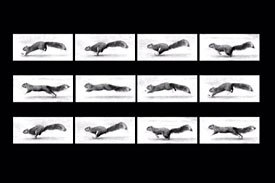Mark Ramshaw reports back regarding the impressive work being done in commercials and music video in the U.K.

Remote from universal nature and living by complicated artifice, man in civilization surveys the creature through the glass of his knowledge and sees thereby a feather magnified and the whole image in distortion... In a world older and more complete than ours, [animals] move finished and complete, gifted with the extension of the senses we have lost or never attained, living by voices we shall never hear. They are not brethren, they are not underlings: they are other nations, caught with ourselves in the net of life and time, fellow prisoners of the splendour and travail of the earth.
For anyone who has spent any time in nature, you realize what a pleasantly boring place it is. Apart from the occasional homicidal hippo or bothersome baboon, animals tend to keep their wary distance from humans. In years of hiking and camping, you would be lucky to see the backside of a bear or mountain lion as it scurries into the brush. This is why we cage animals in zoos, and why our television shows use clever editing to imply a natural world that is red in tooth and claw. Otherwise, we may never have the opportunity to see some of these fellow earthlings.
Are you looking for animals to sketch, or sweating over a particularly dreadful animal walk cycle? Have you lost your copy of Animals in Motion, Eadweard Muybridges classic 1887 photography of animal locomotion? Do you need that extra inspiration to animate your bouncing, dancing animal characters?
Assuming you dont have the benefit to research your subject in the wild, and assuming you dont have the luxury to arrange firsthand animal visits to your studio, the Animal Motion Show from Rhino House is a helpful compromise and a handy reference. As a DVD compilation highlighting the everyday personality of a small assortment of animals, the disc set promises hours of wildlife footage for study and entertainment, handpicked and categorized by professional animators and artists.

Given our affinity for the living world (biophilia), its hard not to enjoy, with childlike fascination, the spectacle of other animals. Volume One of the Animal Motion Show comprises the chimpanzee, kangaroo, squirrel, ostrich and tiger. There is something innately entertaining in watching kangaroos boxing, tigers tackling and squirrels scampering.
In addition, the DVD has general information for each animal, where you can learn such factual trivia as: an ostrich egg can feed up to 20 people; no two tigers have the same pattern of stripes; and, in 1961, a chimpanzee named Ham pioneered space travel for America!
There is upbeat music looping as you spend a few moments intuiting the menu navigation. For each animal, there are three main reference sections: Locomotion, Behavior and Visuals. Each menu item displays its own short clip, and a map provides an overview so that you can jump to any material that may interest you.

Within Locomtion, for example, there may be videos of walking, running, jumping and climbing. Within Behaviors, there are videos of playing, grooming, eating, fighting, mating, and group interaction. Within Visuals, there are close-up videos and photos of the head, body, limbs and even textures.
In the Locomotion submenu, there is a Study feature where you can examine an animals movement in four modes: Normal, Slomo, Grid and Film Strip. The Grid option has a convenient frame counter accompanying its playback, but in any of the modes you can pause the video (or print out images) for a frame-by-frame analysis. There is also a Compare feature where the same actions can be viewed from two different perspectives.
The second disc of Volume One hosts a bevy of special guests. It is not a fastidious selection of shots, but a hodgepodge of video clips grouped into different animal categories: canine (coyote, fox, wolf); feline (jaguar, lynx, puma, ocelot, cheetah); primate (colobus, lemur, baboon); reptile (snake, alligator, tortoise); and extra (bear, anteater, ferret, prairie dog, wolverine).

Volume Two of the Animal Motion Show, a separate disc set, focuses on the elephant, giraffe, hawk, rhino and horse.
The Animal Motion Show offers a lot, and it is put together in a very simple, accessible format. Instead of searching for such a breadth of visual materials, it is readily available at your fingertips with the click of a button. Whether as life study or animation reference, the price tag of $60 for each volume may be a reasonable investment, especially if you amortize the cost over the years of its use; and especially if your next cartoon enterprise involves a chimpanzee, a squirrel and a horse.
It sounds like the opening of a bad joke, but in the end, one hopes the joke isnt on you. If there is any drawback to the Animal Motion Show, it is that there are not more animals on an individual set. No doubt, the series library is growing and other compilations are waiting in the wings.
To find out more about The Animal Motion Show or to order a DVD, visit www.rhinohouse.com.
Greg Singer is a human animal, occasionally in motion. He eats, grooms, plays, fights and mates in Los Angeles.







